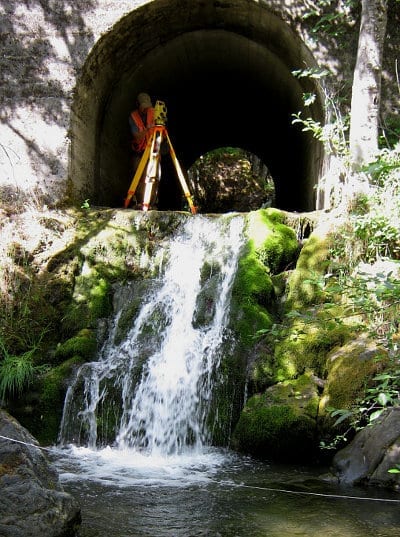Long Defunct Railroad Culverts Still Harming Steelhead, Salmon Populations On Eel River
Traversing the rugged hillsides for several hundred miles along the mainstem Eel River, the Northwestern Pacific Railroad crosses many Eel River tributaries on its way north to Eureka, CA.
The railroad was built in an era when fish passage for adult salmon and steelhead was not a concern, or at least was not adequately protected, and many of the railroad crossings created migration barriers.

This culvert at Dean Creek on the Eel River obstructs spawning habitat (photo Ross Taylor)
Most land ownerships in the Eel River watershed, as in most other North Coast area watersheds, have been surveyed in recent years for migration barriers. The North Coast Railroad Authority (NCRA) Eel River corridor has been an exception.
The railroad is now defunct along the section that runs through the Eel River Canyon, due to numerous irreparable or cost-prohibitive landslides. But the migration barriers remain.
In 2009, a grant was awarded to CalTrout from the CA Department of Fish and Game’s Fishery Restoration Grant Program (FRGP) to assess the NCRA railroad corridor along the Eel River. CalTrout hired the local fish passage expert Ross Taylor and Associates to conduct the fish passage survey.
Those field surveys are now complete, and are currently being summarized in a draft report due to be finished by Ross Taylor in December 2011. According to Ross, his crews have inspected more than 55 stream-railroad crossings, and of those 55, more detailed fish passage surveys were conducted at 20 of them (such as the culvert on Dean Creek shown in the photograph).
The selection criteria for full surveys considers whether or not the streams are fish-bearing and if engineering or construction crews can eventually reach the site.
Of the twenty surveyed sites, at least two have caught the attention of local Fish and Game managers and may be in-line for the next phase of fish passage design and culvert replacement.
Those two sites are Bridge Creek in southern Humboldt County, and Woodman Creek, a large tributary to the Eel located 20 miles northeast of the town of Laytonville (170 miles north of SF). Woodman Creek’s barrier is right at the mouth of the tributary and blocks access to more than 10 miles of good quality habitat, so it should be a worthy investment for a future implementation project.
Fish passage through culverts at stream crossings is an important factor in the recovery of depleted salmonids populations along the Pacific Northwest. Although most fish-bearing streams with culverts tend to be relatively small in size with usually a couple of miles or less of upstream habitat, thousands of these barriers exist and the cumulative effect of blocked habitat is significant.
CalTrout’s new North Coast Area Manager Darren Mierau will continue to work with local managers and area experts to carry out the long process of barrier assessments, prioritization, and replacement to help restore salmon and steelhead access to their ancestral habitat throughout the watershed.
Current NOAA Fisheries guidelines and CDFG criteria for new culvert installation aim to provide unimpeded passage for both adult and juvenile salmonids. Investments in the repair of these sites, although sometimes expensive, provide long-lasting and permanent solutions to aid salmon and steelhead recovery.





4 Comments
I just wanted to set the record straight. The Northwestern Pacific RR parallels the Eel River from Rio Dell to about Nanning Creek (just north of Scotia). This is a distance of about 90 miles. In the begining of this article it states that the railroad follows the river for hundreds of miles. Not true. There is no need to exagerate to make a point.
There is much information about the railway on the accompanying Google link:
http://en.wikipedia.org/wiki/Northwestern_Pacific_Railroad
It would be good to prioritize access to the best habitat first in order to avoid creating ecological traps.
Thanks for the clarification Carl. My intention was not to exaggerate, but I just mixed up my facts.
Sincerely,
Darren Mierau
North Coast Area Manager
CalTrout